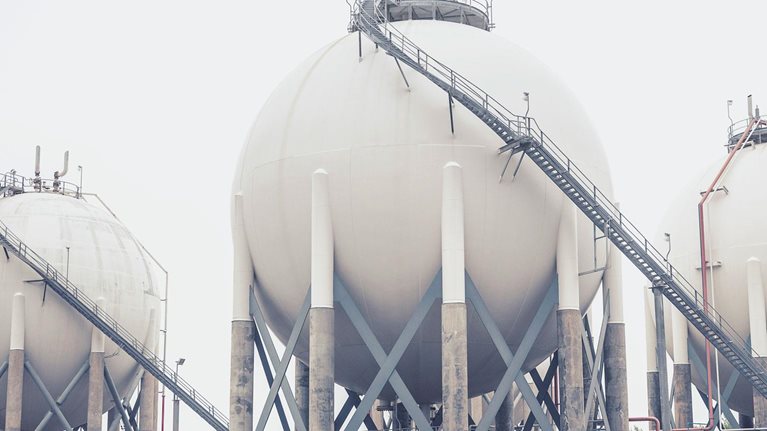Entering 2020, the outlook for North America’s downstream oil and gas industry was one of strong margins, a buoyant economy, and robust demand. The only cloud on the horizon was the potential impact of the energy transition. Companies were building for a future of plenty.
For a decade, downstream companies in North America invested in capitalizing on booming North American shale, retooled their refining and transport capacities, and entered adjacent industries. The sector managed to outperform similar industries in total value creation over ten years (Exhibit 1)—and even as far back as the early 1990s. But there was also a downside. The North American downstream companies developed large, inflexible technical and engineering functions; loosened their control over administrative costs; and failed to seize new opportunities for margin improvement through digitizing refineries.

The global COVID-19 pandemic caught the oil and gas industry unprepared for a completely changed landscape. Planes were grounded and cars parked. Countries outside the Organization of Petroleum Exporting Countries (OPEC) that export crude oil (known as OPEC-plus countries) initially turned up the spigots, and oil prices collapsed. Demand for transportation fuels fell by up to half,1 and storage tanks filled. That forced refineries to cut their rates or even stop production. Oil and gas companies experienced the sharpest shock they had ever seen, and it may also turn out to be their most enduring one.
Long after countries tentatively emerge from quarantine, constantly on the lookout for another surge in COVID-19 cases, the oil and gas industry will face the twin specters: sudden travel interruptions (and longer-term demand decline caused by an economic downturn) and a rise in telecommuting (and the accelerating shift to greener energy sources). We expect the global growth in hydrocarbon demand to peak in the 2030s. As it does, it will expose excess refining capacity and put downward pressure on profits. Adding to the demand-side challenges are vacillation over regulatory policy, the possibility of a breakdown in OPEC’s uneasy production discipline, and the chance that refiners will prolong the glut in petroleum-product inventories by increasing output as soon as their margins improve.
To adjust, oil and gas companies will have to transform radically. Those that succeed will shape the industry’s future; those that fail will become consolidation targets. Even among companies ultimately acquired, there is an important benefit to getting as far down the path of transformation as possible. The further they progress, the higher their valuations will be.
Many have already begun to react. As in past downturns, they are cutting headcount, reviewing operating expenses, and curtailing capital expenditures. Such incremental changes are a start. To emerge from these challenging times with the capability of delivering another decade of long-term growth, companies will have to go much further. They will need strong market perspectives and a clear strategic vision informed by five fundamental changes that define the current downturn (Exhibit 2).

Five key structural challenges
Five structural changes have fundamentally altered North America’s downstream oil and gas market. To adapt successfully to the new and volatile landscape during and after the COVID-19 crisis, companies will need to consider each of the developments as they formulate their short-, medium-, and long-term approaches.
Oceans of inventories
The abrupt demand shock associated with the COVID-19 crisis has created a glut of crude and product inventories, constraining infrastructure in a way that the oil and gas industry had never experienced. With year-over-year inventory increases exceeding 30 percent for certain commodities (for example, diesel2), pipelines slowed, and storage filled up. For the market, that has been an important lesson and warning. Future waves of the COVID-19 pandemic and any failure of OPEC-plus countries to keep a check on supply could again lead to constraints and significant pressure, not only on prices, but also on the downstream oil and gas industry as a whole.
License-to-operate costs
The cost of regulatory compliance for oil and gas companies has tripled since the market downturns of the late 1990s.3 One of the most recent regulatory changes is the International Maritime Organization’s antipollution measure, which restricts the sulfur content of maritime fuels. At the same time, companies are facing an increasingly litigious culture, divided political agendas, and a rise in activism that targets “big oil” and manufacturing.
Paradigm shift in demand
As people have sheltered in place during the COVID-19 pandemic, telecommuting for meetings and working from home have proven to be successful solutions. That success will have a long-term effect. For at least the next couple of years, the number of airline-kilometers flown by paying passengers is projected to remain less than the 8.6 trillion flown annually prior to the crisis, including a reduction of about 50 percent from 2019 to 2020.4 Road use is also likely to feel a lingering impact as more and more large employers explore ways of working remotely after the pandemic.
Change in product mix
The balance in product demand for the oil and gas industry is likely to remain tilted toward diesel and gasoline, with jet-fuel use muted throughout 2021. That will drive refiners to try to alter their product mixes, thereby limiting profits and causing swings in crude-quality differentials. Meanwhile, a sequenced reopening of markets could prompt geographic price arbitrage and instability in micromarkets. Cities, such as El Paso, that are normally net importers of fuels could see prices spike if demand exceeds local refinery-production capacity.
Crude-price instability
OPEC-plus nations have a propensity to act in the interest of their own balance sheets, making for a tenuous alliance. At the start of the COVID-19 pandemic, Mexico, Russia, and Saudi Arabia illustrated how difficult it can be to agree on reciprocal production cuts under duress. And as oil and gas prices have stabilized, the perennial specter of “quota busting” among smaller producers has arisen, potentially undermining compliance among other member nations and causing another drop in prices. That would have a global impact. Continued periods of depressed pricing, for example, could slow Permian Basin activity as unprofitable investments stop. Shifting production volumes would create quicker pricing and demand-market feedback and drive instability. While we expect an average crude ceiling of $40 to $50 per barrel until 2025 under most scenarios,5 those factors are likely to give the industry a bumpy ride.
A three-phase response
Our experience in the downstream oil and gas sector and in partnering with a variety of companies as they drive holistic transformations suggests that a successful response to the fundamental market changes seen in the COVID-19 crisis can be divided into three phases. Those phases build on each other chronologically and overlap (Exhibit 3).

Phase one: Readjust to preserve cash
In phase one, downstream oil and gas companies will need to preserve cash until the market improves. They should exercise the full set of cash-management levers, including reducing inventory positions, lengthening suppliers’ payment terms, reducing receivables terms, deferring capital expenditures, and halting equity disbursements. Many companies have already embarked on several of those efforts. But such actions are just a start. A successful transformation requires a significantly deeper commitment to change.
Phase two: Reimagine to drive performance improvement
In phase two, downstream oil and gas companies will need to take several actions to achieve success:
- Rightsize general and administrative (G&A) functions. Reduce G&A costs—for example, by using industry benchmarks that account for the possibility of continued depressed demand for gasoline, diesel, and jet fuel. Such benchmarks could include measuring the ratio of G&A costs to revenue. Stop unnecessary work and streamline or automate the remaining processes, such as the one for making, approving, and paying for purchasing decisions. Another option is to offshore or outsource activities such as payroll administration. The possible benefits are considerable. Given the fact that industry players have spent a decade positioning themselves for a growth market, we see the potential for a 20 to 30 percent reduction in G&A costs from pre-2020 levels.
- Launch operations improvements. Unlock the full slate of management opportunities in operations and expenditures. Our experience indicates that the average refinery6 stands to boost its margins by up to $1.50 per barrel. To achieve that, companies must take decisive action in several key areas:
- Repair and maintenance. Spend less on maintenance by adjusting the way equipment is operated and managed. That could include measuring the contributions that certain pieces of equipment make to the overall profitability, safety, and environmental footprint of an organization. To illuminate the best course of action, ask questions such as, “How would the failure of our hydrogen-system compressor affect processing capacity, emissions, and repair budget?”
- Operating choices. Update the way decisions are made. As refineries begin to work under new operating conditions, maintenance routines for specific pieces of equipment should be adjusted to ensure correct cost-to-performance trade-offs. Returning to our earlier example of a failing hydrogen-system compressor, that could mean deciding between installing an alternate compressor and extending the life of the existing one by operating it differently. Once new operating conditions are established, more cost-effective maintenance schedules can be safely and prudently established. Options include taking a critical look at how often spares are switched and when new thresholds for vibration or process conditions are established.
- Staffing levels. Reduce technical-support ratios, such as the number of engineers per operating unit, or total engineering spend. There are several ways to do that: focus on the highest-value activities, review when and how to use third-party contractors, cross-train employees so that they can perform multiple tasks, and reconsider overtime practices. An operating plant reduced its project-engineering-labor expenses by 25 percent by changing the way it allocated technical support. It shifted from allocating resources to operating units to sizing the organization for the value of the project portfolio to be supported.
- Product quality. Create value through precision. Limit how often a product exceeds its minimum-quality requirements by improving product-demand forecasting, blending processes, or using in-line-measurement tools. Players with optimized operations planning spend less on the components that make up their finished products, from gasoline to asphalt.
- Operations planning. Precision is a key to running operations more efficiently, especially during times of market volatility. Continually improve modeling to understand how each raw material affects operations. That allows refiners to make better selections and to optimize how plants are operated. Doing so reduces energy consumption and frees up working capital through improved production planning. The potential gain is worth the work. When calculating refineries’ material-balance closure, poor performers find that they cannot account for as much as 5 percent of their throughput. That contributes to suboptimized operations and ill-informed commercial decisions.
- Reconsider supply chain and procurement:
- Midstream. Protect crude- and product-transportation relationships, including pipeline-shipping history and third-party tank positions. Find ways to capture long-term value when infrastructure is choking on crude and products. Initiatives could include guaranteeing favorable logistics and creating value through joint ventures and partnerships. For example, taking an equity stake in a strategic pipeline and signing a long-term storage agreement at a terminal in distress not only help the supplier but also create tremendous lasting value for those players smart enough to spot the opportunity. In that area, the industry does not always decide its own fate, however. Therefore, learn to anticipate the actions of regulators, such as the US Federal Energy Regulatory Commission. Actions range from decisions to award line space based on shipping history before the COVID-19 crisis to reissuing “open season” bidding.
- Purchasing. Streamline the supply chain to reduce costs while ensuring the solvency of critical suppliers. That could include consolidating vendors, renegotiating prices based on volume, understanding “should cost” analysis, establishing long-term supply contracts, and reevaluating the total cost of ownership of equipment. As in midstream operations, strong players will find opportunities to capture long-term value by taking equity positions or negotiating favorable contracts with distressed suppliers, particularly in the areas of capital equipment and consumables.
- Optimize trading capabilities. Adjust crude- and product-trading strategies to account for changing market dynamics. Reductions in North American shale production or long-term reductions in jet-fuel demand would change the relative value of different crudes and constrain logistics for North American refiners. If a domestic shale basin becomes unfavorable, for example, refiners will have to build commercial relationships with operators in the next most desired field. That could take the industry back to the trade flows of the early 2010s, when US refiners imported greater volumes of foreign crudes, such as West African and Arabian light and medium grades. The projected market volatility will challenge organizational strategies. Therefore, reexamine the role of trading operations. Ask questions such as, “Under the changed circumstances, should the trading desk aggressively try to create value or act more conservatively to serve as a feedstock-procurement or product-marketing function?”

Oil and gas after COVID-19: The day of reckoning or a new age of opportunity?
Phase three: Reform to position for growth
In phase three, downstream oil and gas companies will need to take the following actions to achieve success:
- Reimagine functional-support delivery. Introduce zero-based approaches or test the use of more agile support models. Such actions are particularly valuable for multirefinery companies in which resource pooling can be a strong lever. In a cost-focused environment, a shift back toward centralized organization structures could unlock significant value.
- Deploy advanced analytics and machine-learning applications. Integrate new technology up and down the value chain: several areas are ripe for transformation. We have seen terminal-level pricing engines for products help capture margin by understanding local market dynamics, including price elasticity. Digitizing operations has boosted refinery yields and throughputs. Using new software in scheduling and within a supply chain has enhanced maintenance execution, boosting labor productivity and reducing cost. In transportation, digitization has streamlined the movement of crude and products to and from refineries by determining the timing and optimizing the mode of transport (from pipeline to truck, rail, or ship).
- Revamp planning processes. Amid ongoing price volatility, it is particularly important to limit shortsighted investments by improving forecasting and planning. Focus on reducing the risk of overinvesting during peaks and suffering illiquidity during the valleys of future market cycles.
- Reassess portfolio strategies. As transformation illuminates the intrinsic value of assets, build a clear vision for both five- to seven-year strategies and ten-year (and longer) strategies—and the accompanying investment controls. That shapes the foundation for seizing opportunities for growth and value creation in the short and long runs. Where and how companies do that will be determined by their leaders’ views on key issues, such as asset retirements.
In the decade leading up to the demand shock unleashed by the COVID-19 crisis, the downstream oil and gas industry in North America was making the best of a good situation. Refiners capitalized on the twin benefits of a new, abundant, and relatively cheap supply from US shale producers and an increased demand for their own products. Companies shifted their focus from controlling costs to capturing opportunities for growth.
Today, those same companies face a very different world. The global pandemic has not only amplified the weak signals of disruption that have been forming over the past decade but also fundamentally changed the market itself. Players may no longer exhibit the resiliency they mustered during prior oil shocks. To uncover another decade of value growth for shareholders, downstream companies will have to radically transform how they do business. Those that succeed will shape the industry’s future; those that don’t will not survive to tell the tale.

